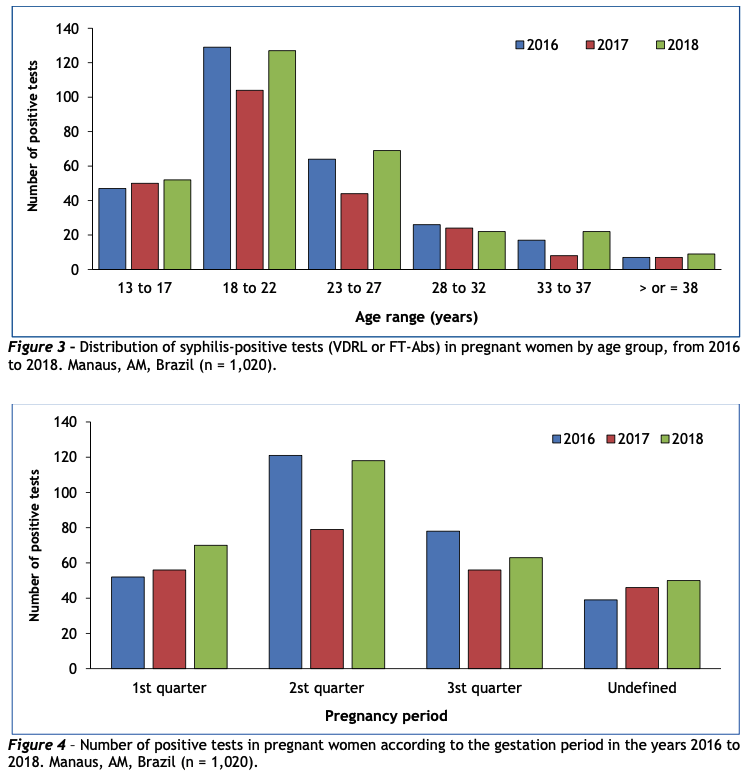Frequency of reagent samples for syphilis in pregnant women treated at Distrital Leste Laboratory, Manaus, Amazonas, Brazil
Main Article Content
Abstract
Objective: Checking the frequency of reagent samples for syphilis in pregnant women treated at the Distrital Leste Laboratory in the city of Manaus from January 2016 to December 2018, comparing the positive VDRL (Venereal Disease Research Laboratory) cases with the confirmatory FTA-Abs (Fluorescent Treponemal Antibody Absorption Test). Methods: The study was cross-sectional and assessed the results of two syphilis diagnostic tests, VDRL and FTA-Abs. Data were obtained using the database of the electronic program SoftLab® and the Laboratory Environment Manager (GAL) and were quantitatively analyzed. Results: In 2016, 9,028 VDRL tests were performed on pregnant women, 8,562 tests in 2017 and 5,064 in 2018. From this total, 1020 tested positive for syphilis; 392 in 2016, 320 in 2017 and 308 in 2018, increasing from 4 to 6%. Comparison with the FTA-Abs was only made possible in 2016 when the diagnosis was confirmed in 82% of the tests. Conclusion: It was possible to check the frequency of pregnant women with positive and confirmatory results from 2016 to 2018, showing that although this pathology is easily preventable, it remains a challenging public health issue in pregnant women.
Article Details
Authors maintain copyright and grant the HSJ the right to first publication. From 2024, the publications wiil be licensed under Attribution 4.0 International 
 , allowing their sharing, recognizing the authorship and initial publication in this journal.
, allowing their sharing, recognizing the authorship and initial publication in this journal.
Authors are authorized to assume additional contracts separately for the non-exclusive distribution of the version of the work published in this journal (e.g., publishing in an institutional repository or as a book chapter), with acknowledgment of authorship and initial publication in this journal.
Authors are encouraged to publish and distribute their work online (e.g., in institutional repositories or on their personal page) at any point after the editorial process.
Also, the AUTHOR is informed and consents that the HSJ can incorporate his article into existing or future scientific databases and indexers, under the conditions defined by the latter at all times, which will involve, at least, the possibility that the holders of these databases can perform the following actions on the article.
References
Avelleira JCR, Bottino G. Syphilis: diagnosis, treatment and control. Brazilian Bras An Dermatol. 2006;81(2):111-26. https://doi.org/10.1590/S0365-05962006000200002
Brasil, Ministério da Saúde. Doenças Infecciosas e Parasitárias: guia de bolso; 8 ed [Internet]. Brasília, DF: Ministério da Saúde; 2010 [cited 2020 Nov 16], p. 1-444. Avaiable from: https://bvsms.saude.gov.br/bvs/publicacoes/doencas_infecciosas_parasitaria_guia_bolso.pdf
Brasil, Ministério da Saúde. Protocolo clínico e diretrizes terapêuticas para atendimento integral a pessoas com Infecções Sexualmente Transmissíveis (IST); 1 ed [Internet]. Brasília, DF: Ministério da Saúde; 2015 [cited 2020 Nov 16], p. 1-122. Avaiable from: https://bvsms.saude.gov.br/bvs/publicacoes/protocolo_clinico_diretrizes_terapeutica_atencao_integral_pessoas_infeccoes_sexualmente_transmissiveis.pdf
Brasil, Ministério da Saúde. Diretrizes para o controle da sífilis congênita [Internet]. Brasília, DF: Ministério da Saúde; 2005 [cited 2020 Nov 16], p. 1-52. http://bvsms.saude.gov.br/bvs/publicacoes/diretrizes_controle_sifilis_congenita.pdf
Brasil, Ministério da Saúde. Boletim Epidemiológico Sífilis 2016 [Internet]. Brasilia, DF: Ministério da Saúde; 2016 [cited 2020 Nov 16];47(35), p. 3-29. Avaiable from: https://antigo.saude.gov.br/images/pdf/2016/outubro/31/2016_030_Sifilis-publicao2.pdf
Newman L, Kamb M, Hawkes S, Gomez G, Say L, Seuc A, Broutet N. Global estimates of syphilis in pregnancy and associated adverse outcomes: analysis of multinational antenatal surveillance data. PLoS Med. 2013;10(2):e1001396. https://doi.org/10.1371/journal.pmed.1001396
Arnesen L, Martinez G, Mainero L, Serruya S, Durán P. Gestational syphilis and stillbirth in Latin America and the Caribbean. Int J Gynaecol Obst. 2015;128(3):241-5. https://doi.org/10.1016/j.ijgo.2014.09.017
Cameron CE, Lukehart SA. Current status of syphilis vaccine development: need, challenges, prospects. Vaccine 2014;32(14):1602-9. https://doi.org/10.1016%2Fj.vaccine.2013.09.053
De Lorenzi DRS, Fiaminghi LC, Artico GR. Vertical transmission of syphilis: prevention, diagnosis and treatment. Femina. 2009;37(2):83-90.
Domingues RM, Szwarcwald CL, Souza Junior PR, Leal MC. Prevalence of syphilis in pregnancy and prenatal syphilis testing in Brazil: birth in Brazil study. Rev Saude Publica. 2014;48(5):766-74. https://doi.org/10.1590/S0034-8910.2014048005114
Bordalo AA. Estudo transversal e/ou longitudinal. Rev Para Med [Internet]. 2006 [cited 2020 Nov 16];20(4):5. Avaiable from: https://bit.ly/35zdf3G
Hernández-Sampieri R, Callado CF, Lúcio MDPB. Research Methodology, 5 ed. Porto Alegre: Penso 2013, p. 1-308.
Silva HCG, Sousa TO, Sakae TM. Incidência de sífilis congênita no estado de Santa Catarina em 2012. Arq Catarin Med [Internet]. 2017 [cited 2020 Nov 16];46(2):15-25. Avaiable from: http://www.acm.org.br/acm/seer/index.php/arquivos/article/view/265/152
Brasil, Ministério da Saúde. Boletim Epidemiológico Especial Sífilis 2019 [Internet]. Brasilia, DF, Ministério da Saúde; 2019 Oct [cited 2020 nov 16], p. 1-44. Avaiable from: https://portalarquivos2.saude.gov.br/images/pdf/2019/outubro/30/Boletim-S--filis-2019-internet.pdf
Brasil, Ministério da Saúde, Secretaria de Vigilância em Saúde. Manual técnico para diagnóstico de sífilis, 1st ed [Internet]. Brasília, DF: Ministério da Saúde; 2016, p. 1-54. Avaiable from: http://www.aids.gov.br/pt-br/pub/2016/manual-tecnico-para-diagnostico-da-sifilis
Organização Mundial da Saúde. Diagnóstico laboratorial de doenças sexualmente transmissíveis doenças transmissíveis, incluindo o vírus da imunodeficiência humana [Internet]. Brasília, DF: Ministério da Saúde; 2015 [cited 2020 Nov 16], p. 1-270. Avaiable from: https://bit.ly/2KfyZcL
Brasil, Ministério da Saúde. Diretrizes para o controle da sífilis congênita: guia de bolso; 2 ed. Brasília, DF: Ministério da Saúde; 2006, p. 1-73. https://bvsms.saude.gov.br/bvs/publicacoes/manual_sifilis_bolso.pdf

